|
 |
|
 |
|
 |
 |
| |
16:9 in English: The Sound of Sentiment: Popular Music, Film, and Emotion
Af MURRAY SMITH
Since the 1950s, popular songs have assumed a much more prominent role in the scoring and sound design of feature films. Like their classical precursors, scores based on a collage of popular songs play a vital role in amplifying and inflecting the emotional import of films. But do the differences between instrumental classical music and popular song require different forms of analysis, if we are to capture the means by which they move us?
The association between popular film and emotion is a long-established part of the lore of cinema, for filmmakers and fans alike. Running alongside this, and indeed long preceding it, is an equally entrenched association between music and emotion. For these reasons, while it is surprising that the place of emotion in film has only recently come to the fore in the study of film, it is less surprising that one of the first areas of film scholarship in which the question of emotion has been explored is in relation to the film score (1). Most of this work has focussed on the tradition of classical film scoring – ‘classical’ both in its reliance on the classical musical tradition, and in its predominance during the classical phase of Hollywood’s history. Two affective functions of the classical score are consistently identified within this literature: |
|
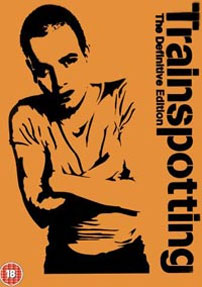
|
|
| |
- expressing emotions (of characters) and moods (of scenes)
- eliciting and arousing emotions in spectators
These two broad functions may, but do not necessarily, coincide (2). According to this body of theory, these emotional effects are created on the basis of musical conventions and a musical culture – broadly speaking, the system of tonality – shared by composer and listener. This does not imply a formal, theoretical understanding on the part of the film auditor, but rather something akin to linguistic competence. Thus, for example, when we respond to the negative emotional character of a cue set in a minor key, or the jarring emotional tenor of the minor third interval, we do so because we know the relevant musical tradition ‘from the inside’, not because we have a formalized, theoretical knowledge of it.
So far, so classical. However, changes in the nature of film scoring have ensured that popular song now often carries the burden of emotional delineation once handled by classical scoring alone. ‘The shift in film scoring in the 1970s and the 1980s,’ writes Simon Frith, ‘reflected…a generational change in what was heard as the basic language of the emotions. For the rock generation popular music was as capable of expressing ‘serious’ emotion as classical music…John Barry as expressive of dramatic tension as ersatz Wagner’ (Frith, 118). But very little has been said on the question of the role and mechanics of song-based collage scores in expressing and eliciting emotion. Doubtless many of the same musical conventions and associations carry over – after all, most popular songs operate within the parameters of tonality – but, by the same token, the song is a particular type of musical form, albeit with a wide array of variants, which present a distinctive set of difficulties (as well as opportunities) when used as the basis of film music. An important part of Jeff Smith’s groundbreaking work is given over precisely to the peculiar problems (and solutions) connected with the pop collage score, but he does not dwell on the impact of the pop collage score on the questions of emotional expression and arousal (3).
It is at this juncture that the question of the significance and weight attached to the lyrical and performative dimensions of popular music arises, since these are the two features of popular music which most overtly distinguish such music from the (by and large) instrumental classical music which characterized the classical score (and still does, insofar as the tradition of classical scoring is still very much alive as a ‘prestige’ format for certain types of film, manifest in the work of composers like John Williams, Jerry Goldsmith, Howard Shore and James Horner).
Lyrical Limitations
When I grew up and first started hearing rock music, pop, and soul, it was the sound that really struck me. The words were, for the most part, pretty stupid.
-
David Byrne (Quoted in Gracyk, 64).
Let’s begin with the question of lyrics. Perhaps the first point to be made here – and this will apply as much to performance as to lyrics – is that the importance of lyrics varies very considerably across the various genres of rock and popular music. Within what Ian Garwood calls the ‘standard pop song’, lyrics are evidently pretty important, since they are clearly articulated and for the most part dominate the mix (Garwood, Screen 41). And there is a line of folk and rock songwriters with obviously ‘literary’ ambitions, evident in the foregrounding of complex lyrics; here I’m thinking of performers like Bob Dylan, Elvis Costello and Aimee Mann. But equally, there are many genres of rock in which lyrical content takes only a back seat, or at most a passenger seat, in the vehicle as a whole. In such songs, the vocals tend to be (deliberately) less articulate and lower in the mix, functioning associatively rather than narratively. That is, while in a Cole Porter or Jarvis Cocker song the vocals will typically clearly establish a character or characters whose experience the song narrates and expresses, in many other songs the vocals instead ‘evoke sequences of loosely related vivid images’, as Robert Walser and Susan McClary put it (Walser and McClary, 286). |
|
(1) See, for example, Gorbman (1987), Kalinak (1992), and Brown (1994). The link between music and emotion has been (and to some extent still is) challenged by the ‘formalist’ tradition of composition and theory – in the writings of Eduard Hanslick, for example – which resists the ascription of any kind of representational, expressive or emotional capacity to music (at least in relation to ‘pure’ or ‘absolute’ music – impure music being precisely the kind of music which imports meaning or affect into music through non-musical means). But the claims of the formalist tradition have been very much on the backfoot in recent decades, subject not only to sociological critique and the claims of other types of musical tradition, but even within musicology and the philosophy of music, in which the study of the representational and affective capacities of instrumental music has become a major tradition, through the work of figures like Leonard Meyer, Peter Kivy, and Stephen Davies. The overtly emotional character of the film score has perhaps, in a small way, spurred on such theorists to demonstrate the way in which instrumental music may possess expressive and emotional functions in and of itself, and not simply in relation to text, moving image, or dialogue.
(2) On this distinction, see Jeff Smith, ‘Movie Music as Moving Music: Emotion, Cognition, and the Film Score,’ in Carl Plantinga and Greg M. Smith (eds.), Passionate Views: Film, Cognition, and Emotion (1999), 146-67. In general, Smith clarifies and distinguishes in this essay functions which are often conflated in discussions of film music.
(3) Smith stresses what he terms the problems of ‘formal autonomy’ and ‘prior meaning’: the fact that pre-recorded songs bring with them a set structure and meaning, or set of meanings, embodied by the song as an autonomous entity. See Jeff Smith, The Sounds of Commerce: Marketing Popular Film Music (1998), especially chapter 7. |
|
| |
An idea drawn from Michel Chion’s writing on film sound will allow us to finesse this thesis. Chion makes a distinction between ‘theatrical’ and ‘emanation’ speech in film: while both phenomena are tied to the human voice, theatrical speech is defined by the use of language where the meaning of the utterances is paramount (chiefly, dialogue and voice-overs) (Chion, chapter 9). Emanation speech concerns those uses of the human voice where verbal, linguistic meaning has been displaced. Applying this distinction to song lyrics, we can say that sometimes lyrics have ‘theatrical’ significance, but only sometimes; on other occasions – and in particularly in ‘non-literary’ song genres – the vocals register a human presence and expressivity, but not through language as such (4).
Perhaps it is time to make concrete some of these arguments, by making reference to the opening and closing cues of Trainspotting (Danny Boyle, 1996), ‘Lust for Life’ by Iggy Pop and ‘Born Slippy’ by Underworld. Though the pieces are very different, in neither case would be it accurate to say that the lyrics dominate the songs. In both cases, the vocals evoke ‘vivid imagery’, but not in a fashion that creates a fully coherent, developing narrative. For example, the vocal track for ‘Born Slippy’ allows us to grasp a number of words and phrases – ‘bad boy, dark boy’, ‘lipstick’, ‘chemicals’, ‘inner space’, and most elaborately, ‘let your feelings slip, boy, but never your mask’ – which resonate associatively with one another (and of course with the narrative of the film). The fact that we can’t fill out the gaps here, and construct a more exact narrative, has much to do with the treatment of the vocals and the mixing of the song as a whole. The vocals are delivered at a fairly rapid pace; reverb on the vocals underlines this sense of rapidity, by literally doubling the musical events that we hear at certain moments; and the vocals are run through a filter which both distorts and mutes them. (And, for what it’s worth, the lyrics are not given to us as text in the CD packaging) (5).
But what happens when a song is worked into the soundtrack of a film – in this case Trainspotting? If anything, the process of remixing a song’s original sonic balance within that of an englobing film soundtrack tends to displace lyrical content even further. This is certainly true of ‘Lust for Life’, in which the lyrics – indeed the song as a whole – are markedly subordinated to Renton’s voice-over after the thumping opening few bars, so much so that the only lyrical fragments that can be heard are the opening line (‘Here comes Johnny Yen again…’) and the choral refrain (‘I gotta lust for life’). In the case of ‘Born Slippy’, the vocals do not have to compete with Renton’s voice-over for well over a minute. Indeed, the song dominates the soundtrack at this point in the film, with a number of sound effects (Begbie snoring, Renton moving around the room) being woven into it without the level of the song being dropped (in contrast to the substantial shifts in level over the course of ‘Lust for Life’). In this case, the action of the film in effect narrativizes the associative imagery of the song’s lyrics. Although the surface details of the process of (re-)editing a song into a soundtrack differ quite markedly in these two examples, the underlying process of a fusion and unification between sound and image is common to both.
An overemphasis on the lyrics of pop songs used in films is, then, as misleading as an overemphasis on the lyrics of pop songs as objects in themselves. In both cases lyrical content has to be seen as just one element of a larger aesthetic complex: in the case of the song, the lyrics are held within a musical structure; in the case of a fiction film, the lyrics are part of a larger audio-visual dramatic structure. Elementary as this point may be, it bears repetition, in the face of the oft-heard lament from composers regarding the ‘abuse’ of musical structure in film scoring. Theodor Adorno and Hans Eisler, for example, complain that the Wagnerian leitmotif ‘cannot be developed to its full musical significance in the motion picture’ (Eisler and Adorno, 6). Of course, a film might make an intricate and conventionally coherent musical structure a priority, but it is under no obligation to do so, and to insist otherwise is to misidentify the relevant aesthetic object. A score, of any sort, is a part of a film, not the whole of it, nor an autonomous layer of it. |
|
(4) And beyond emanation speech there is another possibility: the use of the human voice to create an abstract sonic phenomenon, which is not experienced as deriving from a human source at all; consider, for example, the way Michael Stipe’s voice takes on the timbre of a violin in the opening bars of ‘The Sidewinder Sleeps Tonite’ (on Automatic for the People). Clearly there are sounds in films which have nothing to do with the human voice, but a more daring extension of Chion’s distinction is to think about vocal sounds – in both film soundtracks and songs – which ask to be heard as something other than the sounds of a human voice.
(5) Underworld are, of course, an outfit associated with house and rave culture. Simon Reynolds’ comment on the challenges posed by this style of music for the tradition of rock criticism is pertinent here: ‘Unlike rock music, rave isn’t oriented around lyrics; for the critic, this requires a shift of emphasis, so that you no longer ask what the music ‘means’ but how it works. What is the affective charge of a certain kind of bass sound, or particular rhythm ? Rave music represents a fundamental break with rock, or at least the dominant English Lit and social realist paradigms of rock criticism, which focus on songs and storytelling…Bypassing interpretation, the listener is hurled into a vortex of heightened sensations, abstract emotions and artificial energies.’ Simon Reynolds, Energy Flash: A Journey Through Rave Music and Dance Culture (1998), xix. Setting aside Reynolds’ hyperbole here, readers might be reminded of a certain debate in film studies, triggered by David Bordwell’s Making Meaning (1989)…but that is another story. |
|
| |
Haircuts and Harmony
I have friends who don’t understand why I like Led Zeppelin. They say its dunderhead rock, but they’re not talking about the music – they’re remembering the culture and the people that liked it.
-
Jim O’Rourke (Détourn, 16).
What of the performative dimension of a pop song? To return to the larger question framed by this essay: does the status of performance in popular music, as compared with its status and role in classical music, make a substantial difference to the way in which film scores express and arouse emotion?
What stands behind this question is the intuition that whereas in classical music the composition rules, with performers afforded relatively little opportunity to interpret and rework a score, in popular music performance counts for a whole lot more. One can grasp this norm by exceptions on both sides: just as Glenn Gould is atypical in the world of classical performance, for the boldness of his interpretations and thus for his visibility as a performer, so tribute bands like the Australian Doors and Bjorn Again are rather exceptional in popular music, in that their ambition is to replicate the style of a previous act rather than forge a distinctive new style. But we must pause before going any further, first, to remind ourselves once again that, as with lyrics, the significance of performance varies from genre to genre. Iggy Pop has a persona and iconographic presence of a different sort from that possessed by Underworld. While Iggy’s visage is present on most of the cover artwork for his releases (fig. 1-2), the opposite is true of Underworld, few (if any) of whose releases provide any evidence of the appearance of the band’s members (fig. 3). This is no idiosyncrasy, however, but rather an example of the way the resurgent dance culture of the late 1980s and 1990s sought to downplay star performers in favour of the community as a whole. This shift in emphasis is evident in Trainspotting itself as, although the musical character of the score gradually shifts from the proto-punk of Iggy Pop through to the more recent waves of dance music – recall that the film is bookended by the two examples I’m discussing – no individual figure or icon comes to represent dance culture in the way that Iggy stands for the earlier period, via his presence on the soundtrack and within the narrative itself (fig. 4).
The second reason we must pause before putting any more weight on the idea that performers and performance are more important in popular music than in classical music concerns ambiguities in the word ‘performance’ itself. The crucial distinction I want to introduce here is that between visual performance and musical performance. Brian Eno has defended artists, like Madonna, for whom visual performance constitutes a major part of their act: ‘Who said music should be at the centre of the experience ?…Why not…accept the idea that the music itself could become the package – an interesting way of presenting a series of modern haircuts, for example?’ (Eno, 374). What’s important for Eno is that we shouldn’t get so hung up on defending the music of popular music as to obscure its theatrical, media and fashion-related dimensions, which in some cases might be where the aesthetically interesting action is going on. I think Eno is right, but I’m concerned that another kind of performance – musical performance – can itself be obscured by this argument.
By musical performance I mean nothing more mysterious than the manner in which a musician plays or sings in order to create or contribute to a piece of music. But by distinguishing musical performance from visual performance, and focussing on it, I hope to reveal two important and novel theses. Step back for a second, and recall that our overarching question concerns whether theories concerning the emotional functions of classical instrumental scores will carry over to scores based on a collage of popular songs. In classical music, performative nuances are certainly significant, and there are of course star performers whose particular styles are recognizable to those ‘inside’ classical musical culture. So the idea that there is a strong contrast between classical music and popular music in terms of the significance of musical performance holds less water than it appears to (Davies, 193-204). However, in classical film scoring the situation is different: it is rare for a distinctive star musician to be employed as part of the ensemble for a classical score, and in any case, most audience members would probably not be in a position to register the subtleties of their style (6). To the extent that there is an awareness of a personal or authorial presence attached to the music of film scores, it is with a handful of well-known composers, not performers. Most classical scores are, in this sense, performed in a relatively anonymous fashion, and in this respect there is a marked contrast with popular songs used in scores, where the particular features of a particular musician’s performative style are vital to, even constitutive of, the expressive and emotional qualities of the music. (For this reason there is something faintly absurd about rock songbooks which represent songs in conventional musical notation – so important are the idiosyncratic aspects of musical performance which are, for the most part, invisible to such notation.) We are talking here about musical performance, not visual performance or performance in general. In analyzing the opening sequence of Trainspotting and the way ‘Lust for Life’ works within it, it is all too easy to drift into an analysis which focusses on Iggy’s appearance, stage antics, public persona, and life history – in short, everything but the way in which the bold stomp of the opening bars of solo drum immediately establish an in-your-face, back-to-basics attitude; the propulsive, swinging rhythm introduced by the interlocking guitar and bass patterns, a rhythm which remains unbroken through the rest of the song; the gradual accumulation of instrumental density over the first minute of the song, preceding the entrance of the vocals (at 1’12’’ – more than a fifth of the song elapses before a word is sung); the salacious, sneering quality of Pop’s voice when it finally arrives; the bright, clattering ‘soundscape’ created by the song’s production. In sum, while it is often appropriate to analyze both visual and musical performance, as it is here, commentary on visual performance should not become an alibi for a lack of attention to musical performance – just as (over-)attention to lyrics should not act as a diversion from attending to songs as musical works. |
|
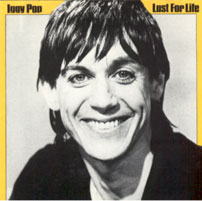
Fig. 1: Iggy Pop, Lust for Life (1977).
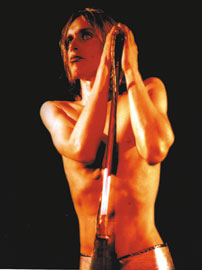
Fig. 2: Cover still for Iggy and the Stooges, Raw Power (1973).
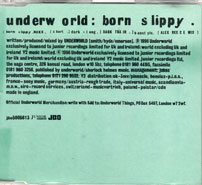
Fig. 3: Born Slippy.
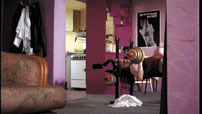
Fig. 4: Notice the poster in the background: “Iggy Pop and the Stooges”.
(6) There are exceptions: Itzhak Perlman performs on the score of Schindler’s List (Steven Spielberg, 1993), for example, and Yo-yo Ma on the score of Crouching Tiger, Hidden Dragon (Ang Lee, 2000). But cases like these are so exceptional as to prove the rule.
|
|
| |
The notion of musical performance also clarifies a hesitation in my earlier remarks on lyrics – a hesitation between reference to lyrics and to vocals. Vocals are, of course, vocalized or performed lyrics, and it is no accident that as my discussion of the place of lyrics became more concrete, so there was a tendency on my part of speak of ‘vocals’ rather than ‘lyrics’. What we can add to those earlier comments, then, is that analysis should focus on vocals rather than lyrics, as, at least in popular music, it is in the process of vocalization that lyrics become part of the larger musical fabric of a song. Theodore Gracyk tells it like it is: ‘To be blunt, in rock music most lyrics don’t matter very much. Or, to be more precise, they are of limited interest on the printed page, divorced from the music’ (Gracyk, 65). To analyze the lyrics per se, as an abstracted textual entity, is rather like examining a film’s screenplay (Frith, chapter 8, discusses this matter in detail). There is nothing wrong with this, so long as we don’t confuse it with the entity that we actually engage with (the film, the song-as-performed).
Born Slippy: Motion and Emotion
Most of this essay has been given over to considering the differences between classical and popular music. But as I noted at the outset, classical film scoring and the popular songs used in collage scores both, on the whole, operate within the system of tonality. I want to end, therefore, with a brief example which stresses the continuities between the emotional functions of classical and popular music in the film score, and the kind of musical analysis necessary to grasp these functions. I will focus on the use of pitch, and especially rhythm, in ‘Born Slippy’, and the impact of these musical factors in articulating the dramatic shape of the final scene in Trainspotting. I will also be concerned to stress the way in which the expressive and dramatic effects of the music are dynamic rather than static, as well as the fact that the relationship between music and image is constantly shifting in more or less overt or subtle ways. |
|
|
|
| |
‘Born Slippy’ begins with an extended minor chord, played on a synthesizer, which initiates a simple, melancholic melodic phrase which will be repeated for roughly the first minute of the song. The cue actually begins at the end of the previous scene, over a medium close-up of Renton and Begbie in silhouette, as they face each other in a tense stand-off following Begbie’s assault on an innocent bystander in the pub. At one level the cue functions simply as a sound bridge, ensuring a smooth flow of action into the final scene. But the cue performs an expressive function in addition to this structural function. Renton appears to be on the brink of confronting Begbie, rejecting his violent, bullying behaviour (which is of course what he does do indirectly by leaving in the final scene). Recognizing this, Begbie pre-empts such a move by Renton, by staring him down and compelling Renton to light a cigarette for him. In a further gesture of psychological domination, Begbie blows smoke directly into Renton’s face (fig. 5-6). Although this is a profoundly aggressive act, in physical terms it is mild – Begbie exhales and the smoke whorls drift into Renton’s face. The minor chord which opens the cue has a complex relationship to these visual gestures. The instrumentation of the chord – a synthesized choir – along with its setting in a minor key resonates with the gentleness of the physical gesture. But, as we have seen, the gesture is at the same time psychologically violent – and in this sense the music acts in counterpoint to the action. Once the film cuts to the next scene, these same instrumental and harmonic qualities will cohere more directly with the visual action. Thus, over the first few seconds of ‘Born Slippy’, we ‘audio-view’ a complex interplay of parallelism and counterpoint between image and sound. |
|
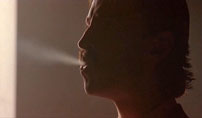
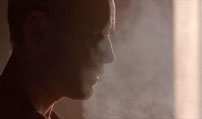
Fig. 5-6: Trainspotting (1996). |
|
| |
After the cut to the final scene has occurred, the slow rhythm and downbeat emotional quality of ‘Born Slippy’ works to reinforce the rhythm and mood of the action as it is established visually: the editing rhythm is fairly slow and there is little movement in the opening shots of the scene – Renton lies awake in bed, chewing his nails, while the rest of the gang sleep. However, there is a further layer of rhythmic complexity in the song, which serves to prefigure later developments in the scene. Although the underlying rhythm established by the synthesizer chords is slow, a ‘secondary’ rhythm is established by the reverb placed on some of the chords, such that many musical events are ‘shadowed’ by an echo quickly following on the initial event. This sense of a second, faster rhythm being held within the slower rhythm is underlined with the entrance of the vocals, which are delivered at a fast tempo, and with a sharp attack on some of the words, that accords with the ‘secondary’ faster rhythm. Now, the ‘secondary’ rhythm is established very soon after the first, while Renton is still sitting on the bed (fig. 7), so we cannot say that it simply mirrors something else in the mise en scene. Rather, it anticipates the gradual tilt towards action in the scene, which occurs as Renton gets up, examines himself in a mirror (fig. 8), drinks some water (fig. 9), and moves towards Begbie (fig. 10). It is at this point in the scene that the ‘secondary’ rhythm asserts itself in the song – becoming, in effect, the ‘primary’ rhythm – initially through a rapid hi-hat beat which fades up, then still more emphatically as a bass drum enters, pounding out an emphatic ‘four-to-the-floor’ dance beat. The faster rhythm now meshes with the rapid, purposeful movements of Renton as he engineers his stealthy escape; indeed, the bass drum seems to mimic the pulse of a racing heartbeat, entering as it does just at the moment that Renton lifts the bag from Begbie (fig. 11, 12, and 13). In fact, at this point the song becomes almost entirely rhythmic, consisting of layers of percussion and chanted vocals, the harmonic structure established by the synthesizer chords and melodic motif disappearing altogether. In sum, the scene moves from stasis and contemplation to action, and it exploits the rhythmic complexities of ‘Born Slippy’ both to give direct expression to these states (of weariness, of regret, then of urgency) as well as to adumbrate them.
By way of conclusion, I want to make one further point regarding the importance of musical performance, as distinct from performance in a broader sense. An oft-cited anxiety attending the use of pop songs in film scores is that, while such songs are excellent at evoking period and place, they are also apt to date badly once the aura of associations connected with a particular song or performer fades from living memory. In other words, both the power and the long-term vulnerability of the pop song are thought to be vitally connected with the cultural context with which they were first associated. However, once we register the crucial role of musical performance in pop songs, this argument begins to look rather alarmist. Assuming that we have an understanding of the relevant musical idiom as a whole, then many of the qualities that we might assume, on first glance, to be holistic qualities of an entire cultural moment and in that sense impossible to ‘locate’ in a precise way, in fact turn out to be the very stuff of musical performance. In this sense, they are ‘locatable’ through just the kind of musical analysis that I’ve sketched in this essay – a form of analysis adapted to recognize both the differences and similarities between classical and popular music. And so it is that spectators not even born at the time Iggy Pop released ‘Lust for Life’ can understand very clearly the force of this musical cue – just as older audience members who may never have set foot in a rave can still be alive to the emotional qualities of ‘Born Slippy.’
Thanks to Jeff Smith for helpful comments and advice on an earlier draft of this essay. |
|
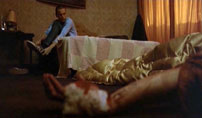
Fig. 7: Trainspotting (1996).
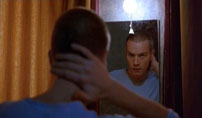
Fig. 8: Trainspotting (1996)
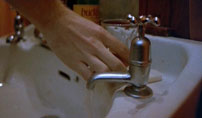
Fig. 9: Trainspotting (1996)
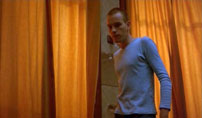
Fig. 10: Trainspotting (1996)
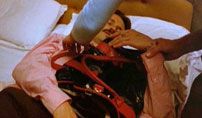
Fig. 11: Trainspotting (1996)
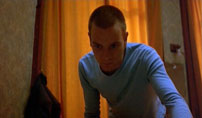
Fig. 12: Trainspotting (1996)
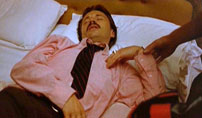
Fig. 13: Trainspotting (1996) |
|
 |
 |
 |
 |
 |
|
 |
 |
 |
| |
Facts
Literature
Bordwell, David. Making Meaning (Cambridge: Harvard Univ. Press, 1989).
Brown, Royal S. Overtones and Undertones: Reading Film Music (Berkeley: University of California Press, 1994).
Chion, Michel. Audio-Vision: Sound on Screen, trans. Claudia Gorbman (New York: Columbia University Press, 1994).
Davies, Stephen. ‘Rock Versus Classical Music,’ Journal of Aesthetics and Art Criticism 57: 2 (Spring 1999), 193-204.
Détourn, Gal. ‘American music club of one,’ interview with Jim O’Rourke, Making Music 190 (February 2002).
Eisler, Hanns and Adorno, Theodor. Composing for the Films (Dobson, 1947).
Eno, Brian. ‘On being on artist,’ in A Year: With Swollen Appendices (London: Faber, 1996).
Frith, Simon. Performing Rites: Evaluating Popular Music (Oxford: Oxford University Press, 1996).
Garwood, Ian. ‘“Must you remember this ?”: orchestrating the 'standard' pop song in Sleepless in Seattle,’ Screen 41 (2000).
Gorbman, Claudia. Unseen Melodies: Narrative Film Music (London: BFI, 1987).
Gracyk, Theodore. Rhythm and Noise: An Aesthetics of Rock (Durham: Duke University Press, 1996).
Kalinak, Kathryn. Settling the Score: Music and the Classical Hollywood Film (Madison: University of Wisconsin Press, 1992).
Reynolds, Simon. Energy Flash: A Journey Through Rave Music and Dance Culture (London: Picador, 1998).
Smith, Jeff. The Sounds of Commerce: Marketing Popular Film Music (New York: Columbia University Press, 1998).
Smith, Jeff. ‘Movie Music as Moving Music: Emotion, Cognition, and the Film Score,’ in Carl Plantinga and Greg M. Smith (eds.), Passionate Views: Film, Cognition, and Emotion (Baltimore: Johns Hopkins University Press, 1999).
Walser, Robert and McClary, Susan. ‘Start Making Sense! Musicology Wrestles with Rock,’ in Simon Frith and Andrew Goodwin (eds), On Record: Rock, Pop and the Written Word (London: Routledge, 1990).
|
|
|
|
|
 |
 |
 |
 |
16:9 - november 2006 - 4. årgang - nummer 19
Udgives med støtte fra Det Danske Filminstitut samt Kulturministeriets bevilling til almenkulturelle tidsskrifter.
ISSN: 1603-5194. Copyright © 2002-06. Alle rettigheder reserveret. |
11 |
|
|
 |
 |
|
|